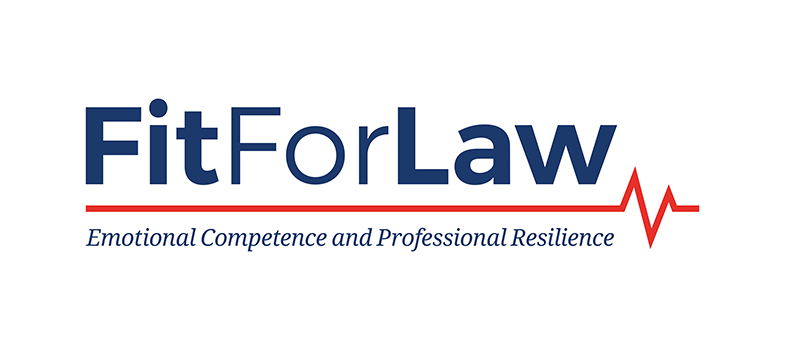3. Knowing your limitations
This section includes:
- Explanatory text
- A “Questions to ask yourself” checklist
- 1 video.
You should allow yourself 20 minutes to complete this section.
One of the many useful functions different emotions can perform is acting as a form of “early warning signal” (Zautra, 2006, p.9). Often this “signal” will take a similar form each time you experience it. For example, you could get irritable, angry, argumentative, tired, feel ill or feel less caring towards, or interested in, others.
This type of "signal" is particularly relevant in legal practice when you may be given tasks or expected to perform in ways you find uncomfortable or challenging. For example, as a trainee solicitor or chartered legal executive, or pupil at the Bar, you may be faced with a client demanding immediate advice on a topic you have not previously researched in detail. In many legal roles, you may be expected to perform managerial tasks which your training did not equip you for (such as supervising and/or leading others).
Listening to your emotional response and understanding the signal it is providing can help you to think about whether or not you are competent to take on a task or role. If you aren’t competent, the consequences can be significant for both you and others involved.
You may also want to think about the "early warning signals" of those around you, for example, your manager, supervisor, support staff or other colleagues. If you can identify these "signals" it will help you understand when that individual is under stress, help you avoid taking their reaction too personally, and also encourage you to be aware of when that person may need some form of additional help and support.
To be able to put your emotional response in context, you need to think about whether you do have the competence to take on what is being asked of you.
The following video discusses the importance of acknowledging and understanding your limitations.
Acknowledging your limitations
Interactive feature not available in single page view (
see it in standard view).
The following diagram provides a useful checklist to help you consider your limitations, but you may wish to adapt it to suit your own legal workplace and ways of practicing.
Questions to ask yourself
Timing: You should allow around 20 minutes for this activity
You can click on each possible answer to see ways to tackle the issue.
Active content not displayed. This content requires JavaScript to be enabled.
Show description|Hide descriptionDo you have the appropriate qualifications and training (for example, if you are a barrister specialising in commercial work, do you have the knowledge and skills to accept a brief in a criminal matter)?
Yes: Whatever part of the legal profession you are in, you need to know the regulations governing your work so that you can operate within these.
No: If the answer is no then you need to focus on how you can communicate this effectively to your employer, client or other stakeholders. Section 3.1 has further guidance on this.
Unsure: It is important to take time to research this, and err on the side of caution. A wrong decision could impact on your professional standing.
Interactive feature not available in single page view (
see it in standard view).
Active content not displayed. This content requires JavaScript to be enabled.
Show description|Hide descriptionDo you have the appropriate legal knowledge and understanding?
Yes: This is a great start, but might not be sufficient on its own, so it is important to answer the other questions too.
No: Be realistic – is this something you can learn to the level required in the timescale allowed? If so, do you have the enthusiasm and resources to do so? Do you need to attend a training course? If so, are there time and resources provided for you to do that? If it is not something you can learn then at this point you need to communicate that this is not something you can agree to/continue with.
Unsure: It is important to find out the answer to this question. It may help you to discuss it with a colleague, manager or supervisor, take the time to do some preliminary research online or seek some guidance from your professional body.
Interactive feature not available in single page view (
see it in standard view).
Active content not displayed. This content requires JavaScript to be enabled.
Show description|Hide descriptionDo you have the appropriate legal skills?
Yes: Having the appropriate legal knowledge, understanding and skills are all vital. Don’t forget to factor in ‘soft skills’ too and make sure you have the emotional competence to take this forward.
No: Be realistic – is this something you can learn to the level required in the timescale allowed? If so, do you have the enthusiasm and resources to do so? Do you need to attend a training course? If so, are there time and resources provided for you to do that? If it is not something you can learn then at this point you need to communicate that this is not something you can agree to/continue with.
Unsure: You may need to do some more research into the skills required, perhaps by speaking to other legal professionals, your professional body or a friend or family member who can provide you with an ‘outside’ opinion.
Interactive feature not available in single page view (
see it in standard view).
Active content not displayed. This content requires JavaScript to be enabled.
Show description|Hide descriptionDo you feel confident in taking this on?
Yes: This is a positive sign. It is a good idea to make a note of the reasons you feel confident, so that if there are times you start to doubt yourself, or worry you made the wrong choice, you can remind yourself of why you felt confident you can do this.
No: If this is a signal that this isn’t the right choice for you, then it's worth spending some time reflecting on your emotions now before making a decision. However, if your automatic response is to assume you can’t do it, then you need to focus on ways to improve your self-confidence. You may find this link useful: https://www.thelawyer.com/ increasing-self-confidence-work/ ?nocache=true&adfesuccess=1 [Tip: hold Ctrl and click a link to open it in a new tab. (Hide tip)]
Unsure: You may find this link useful: https://www.thelawyer.com/ increasing-self-confidence-work/ ?nocache=true&adfesuccess=1
Interactive feature not available in single page view (
see it in standard view).
Active content not displayed. This content requires JavaScript to be enabled.
Show description|Hide descriptionWill this impact on your wellbeing?
Yes: If you think the impact will be positive, that’s great. If you think it will be negative, you will need to think carefully about whether any gain is worth the potential impact. If you do choose to go ahead, make a mental (or physical) note to regularly review your wellbeing (or put a scheduled reminder in a personal diary to remind you), to ensure you can ask for help before things start to feel too challenging or overwhelming.
No: Make a mental (or physical) note to review this at regular intervals so you can spot if things change. Consider putting a scheduled reminder in your diary to prompt you to think about this once the task is underway.
Unsure: It is important to think about this just as carefully as you have any of the other questions before you make your decision. Also, remember your answer to this isn’t set in stone – it is fine to change your mind at a later date.
Interactive feature not available in single page view (
see it in standard view).
Active content not displayed. This content requires JavaScript to be enabled.
Show description|Hide descriptionDoes this raise any ethical issues or conflict with your personal or professional values?
Yes: Although this happens to be the final question, it is an extremely important one which should always be considered. If you have any ethical concerns or feel there is a conflict with your values, it is important you do not ignore this and discuss the situation with family, friends, colleagues or your relevant professional body.
No: Although this happens to be the final question, it is an extremely important one which should always be considered.
Unsure: Although this happens to be the final question, it is an extremely important one which should always be considered. If you have any ethical concerns or feel there is a conflict with your values it is important you do not ignore this and discuss the situation with family, friends, colleagues or your relevant professional body
Interactive feature not available in single page view (
see it in standard view).


